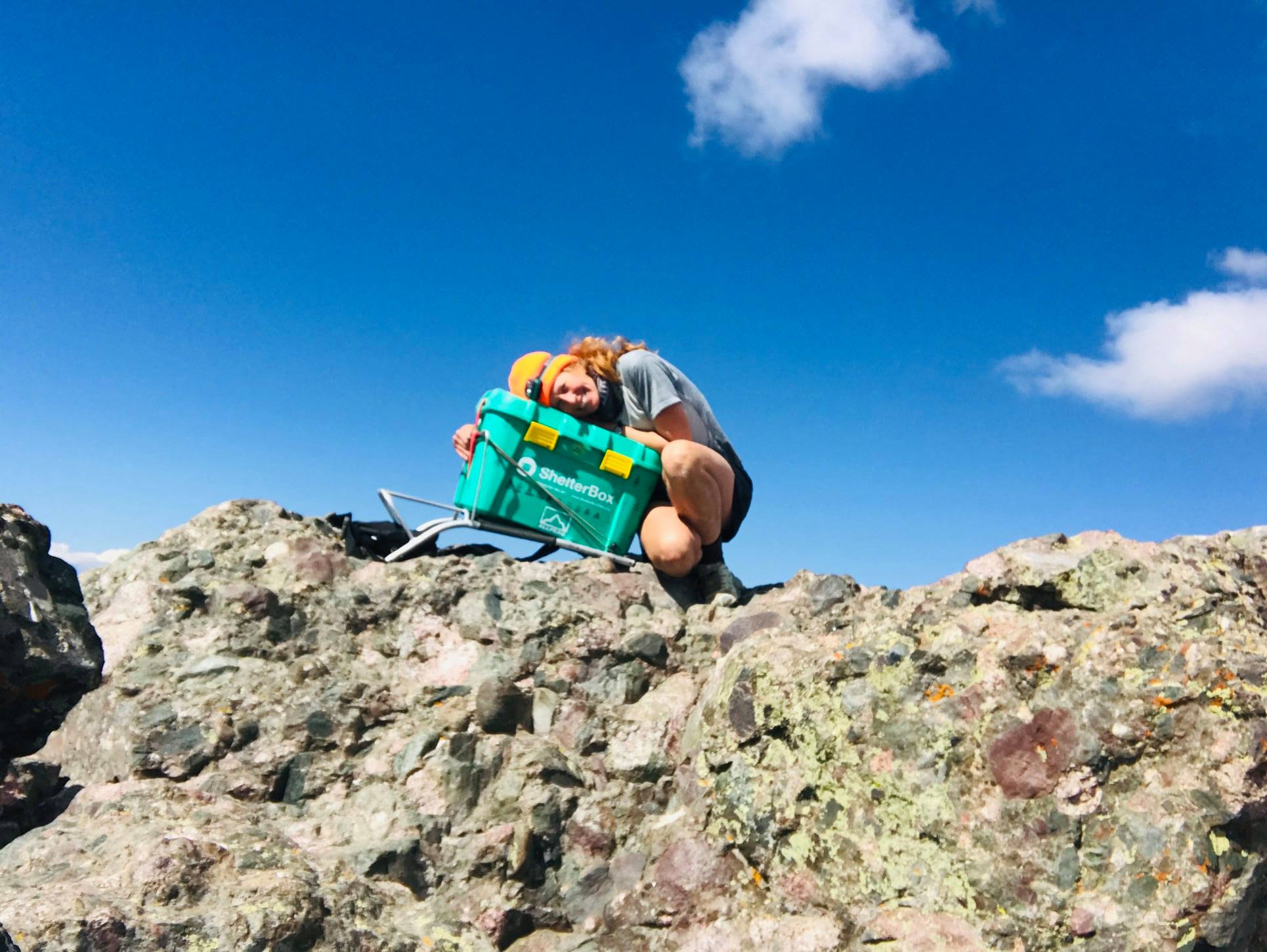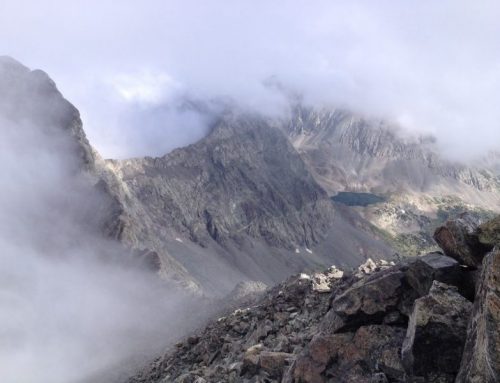 In the summer of 2020, I climbed all 58 of Colorado’s 14ers with a giant turquoise box on my back to raise money for ShelterBox, an INGO dedicated to providing the basic necessities to communities who have lost everything as a result of war, conflict, or natural disaster. Climbing these mountains in quick succession had its benefits: it allowed my body to adjust to the elevation and physical demands of the climbs, all while providing a very set timeline to completing my goal. Sadly, setting such a goal also encouraged me to develop a certain type of tunnel vision, as clear dangers were foolishly diminished or ignored in pursuit of these summits. Reminiscing on that summer feels like remembering a book I once read, with each day and individual climb serving as a chapter therein. While each mountain provided its own unique challenges and lessons, there was probably no mountain, or pair of mountains for that matter, that humbled me more than the Crestones.
In the summer of 2020, I climbed all 58 of Colorado’s 14ers with a giant turquoise box on my back to raise money for ShelterBox, an INGO dedicated to providing the basic necessities to communities who have lost everything as a result of war, conflict, or natural disaster. Climbing these mountains in quick succession had its benefits: it allowed my body to adjust to the elevation and physical demands of the climbs, all while providing a very set timeline to completing my goal. Sadly, setting such a goal also encouraged me to develop a certain type of tunnel vision, as clear dangers were foolishly diminished or ignored in pursuit of these summits. Reminiscing on that summer feels like remembering a book I once read, with each day and individual climb serving as a chapter therein. While each mountain provided its own unique challenges and lessons, there was probably no mountain, or pair of mountains for that matter, that humbled me more than the Crestones.
Before this summer, I had never climbed a Fourteener. Being from Kentucky, I’d grown up exploring the Appalachian Mountains but had never ventured beyond 10,000 feet. As an avid thru-hiker, I revel in the outdoors, often joking that I feel more comfortable in the woods than a traditional home. Although it is a great privilege to take a long walk that spans months and miles, it is by no means easy. Aside from the obvious physical challenges, there are often financial stressors, emotional doubts, and mental fatigue. The latter serves as perhaps the most important factor in such a venture and is one with which I am all too familiar. It was this familiarity that fueled my confidence throughout the summer because the fact of the matter is: climbing a mountain is often more mental than physical. Despite having an immense amount of imposter syndrome at the onset of my journey, I felt emboldened by my mental fortitude. I knew that if I could continuously convince myself to just keep going, I would make it to the top of these mountains, and that is exactly what I did… but it certainly wasn’t easy.
The Crestones sat atop a special pedestal in my mind. Even before I’d started climbing, fellow hikers warned me about them, and on Day 2 of my journey as I sat atop Little Bear looking northward, I began to understand why. The Crestone’s twin jagged peaks seemed to spell danger for anyone who dared to venture up them, and even later throughout my adventure as I knocked off equally infamous peaks, such as Capitol, the Maroon Traverse, and the Wilson Group, I couldn’t shake the feeling that the hard stuff had yet to come and that the clock was ticking.
The summer climbing season in Colorado is very narrow. Climbers can often bank on good weather throughout July and August, but September is always a wild card. Having started my project on July 10th, I was blessed with incredible weather for my first two months. However, at the end of August, Colorado was set ablaze with three separate forest fires engulfing the state, cloaking the mountains in smoke and closing many roads and trails. Then on September 8th, it snowed and didn’t stop for four days. Overnight Colorado seemed to go from fire to ice, and dreams of accomplishing my goal seemed to freeze with it. At that time, I still had five mountains to go: Snowmass, Humboldt, Challenger, Kit Carson, and the Crestones. Looking up at their freshly blanketed peaks, I feared the worst and found myself constantly checking the weather forecast, praying that the rest of September would be sunny. As the days went by, I felt restless and at the mercy of Mother Nature, but then the snow stopped. Knowing time was of the essence and fearing another impending snowstorm, I convinced my friend, Chase, to hike up to South Colony Lakes with me. Our plan, though unconventional, was to knock out five mountains in two days; we returned having only summited one. Despite having waited a few days for the Sun to melt some of the ice and snow, the Crestones’ Brokenhand Pass had hardly seen any sun. Even with snowshoes, crampons, and an ice axe, the fresh snow was too soft and the incline too steep to make any real progress. As I unsuccessfully tried repeatedly to move forward, post-holing up to my waist and frustrated to tears, I told Chase I couldn’t do it. No amount of grit or mental fortitude was going to make up for my physical incapability against nature. Although I had turned back on climbs before due to weather or illness, never had I quit because I simply couldn’t hack it. This experience seemed to solidify every inkling I’d ever had about the Crestones: they were untouchable and I would never climb them.
As September continued, the Sun remained, melting the northern-most sides of most of the mountains. Seeing a window of opportunity, I knocked out Snowmass in a one-day, 22-mile push and then drove straight to the tiny community of Crestone to complete Challenger and Kit Carson the following day. This meant that just the Crestones stood between me and the completion of my goal. However, with the memory of Brokenhand Pass’s frozen gully still very present in my mind, I hesitated to return to the south side of the Sangre de Cristos just to be rejected again. Feeling mentally and physically drained, I wondered if I shouldn’t just call it quits and grant the twin peaks their victory. I had read, however, that there was a less common trail just south of Crestone called Cottonwood Creek Trail that granted access to the Crestones’ north faces, avoiding Brokenhand Pass altogether. Many noted that it wasn’t a clear trail and included a significant amount of bushwhacking, but seeing it as my last option, I decided to try it.
The next morning, I woke up early with a fresh alpine start. The trail turned out to be much more obvious than I’d anticipated, yet the physical exhaustion from the two long days of hiking prior weighed on me. I eventually made it to Cottonwood Lake and collapsed. I was so tired, and looking up at the two Crestones in all their majesty, something inside of me broke. Despite having come so far, these two mountains that had haunted me from the beginning still held something over me. It was then that I called Chase and told him I was turning back; I couldn’t do it… again.
As I sat there by the lake, bathing in the Sun, feeling defeated and reminiscing on my summer, I remembered the greatest lesson these mountains had taught me. You see, mountains provide very clear physical goals. Nowadays, it seems that many of the obstacles we face in our dayto-day lives are abstract challenges whose summits are not so obvious. It’s sometimes hard to know whether you’re making progress at all, but with mountains, the goal is clear: there is a peak, and if you can convince yourself to keep putting one foot in front of the other, you’ll eventually make it to the top. Furthermore, once you reach the top, all the pain and effort that it took to get there melts away into an intoxicating feeling of accomplishment as you can truly asses— in 360 views— just how far you’ve come. Being able to apply that lesson of gradual gains along a path to a greater goal has helped me in every aspect of my life, and it was that same mental fortitude that convinced me that I— a flatlander from Kentucky— could climb these mountains from the start.
It was that notion that got me up the Red Gully that day. It wasn’t pretty, and I probably broke the record for the slowest mile, but as I sat atop Crestone Peak looking over to the Needle, I felt I’d done what I thought to be impossible. With just one mountain to go, I had a decision to make. I could easily climb down and knock out my final peak or even try for the traverse, but after a summer overflowing with incredible memories shared with friends and the unique community that joined me throughout much of this journey, a solo finish did not feel right. Plus, I was exhausted. Therefore, I happily climbed down Crestone Peak, returning five days with friends in tow to summit my final peak, Crestone Needle.
– Brittney Woodrum


